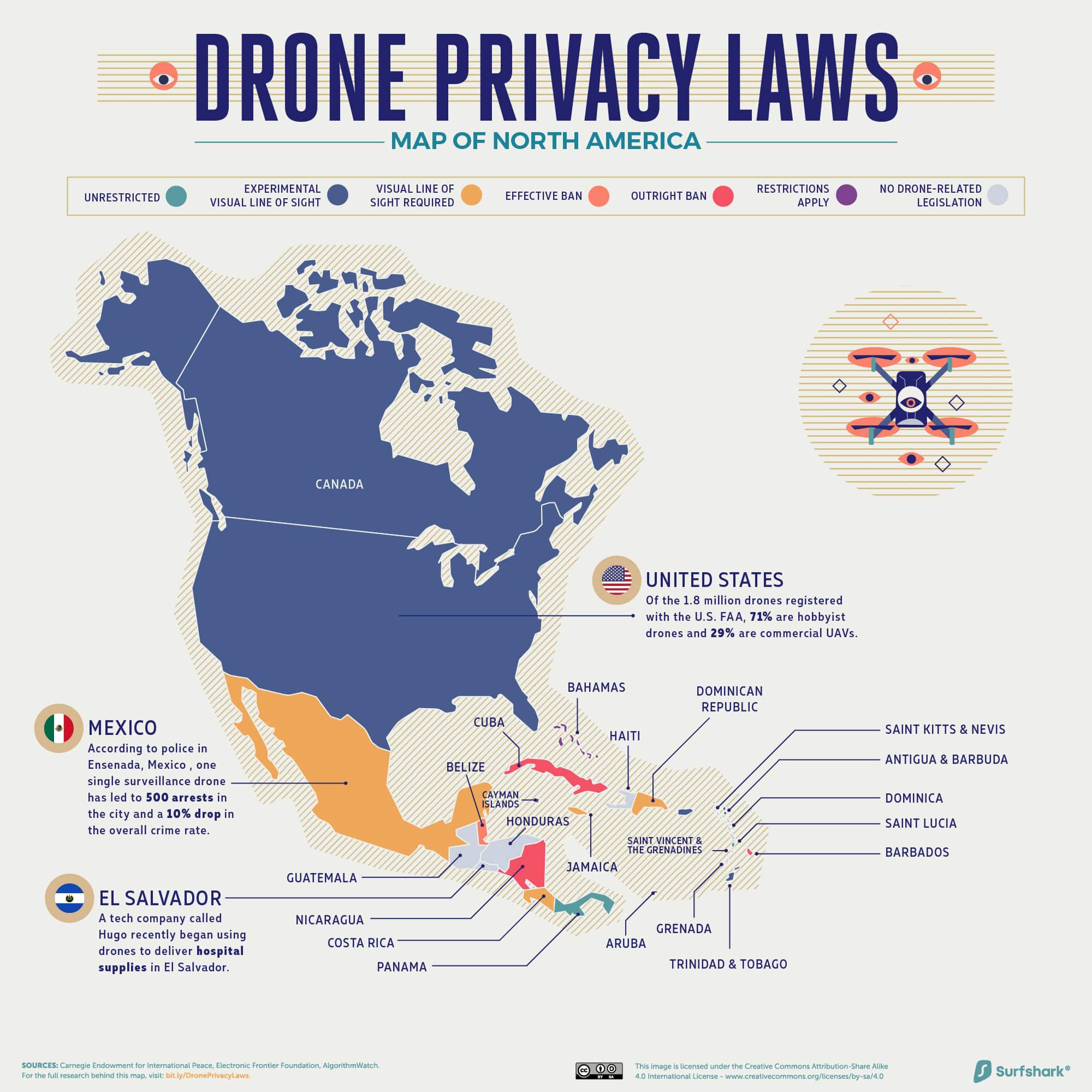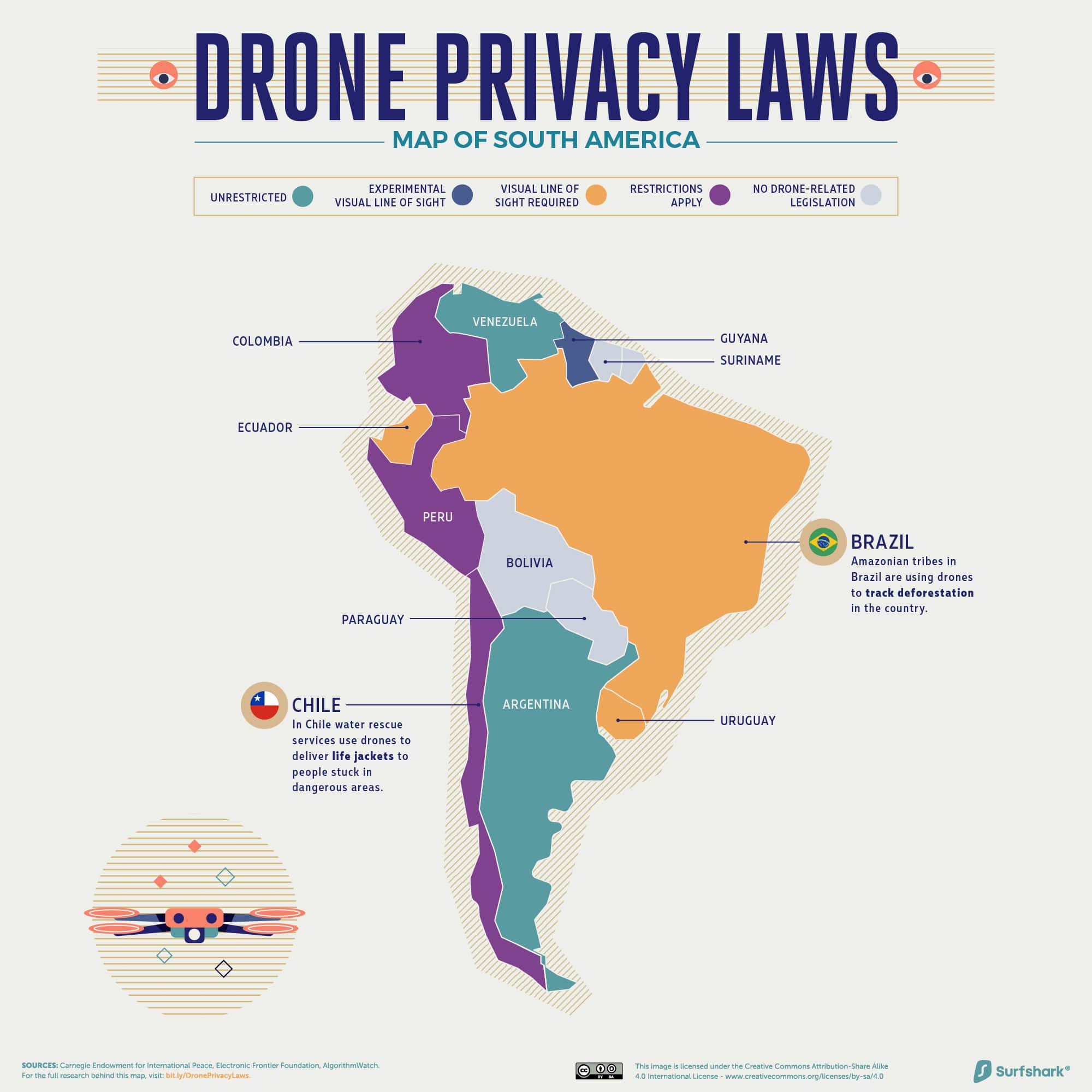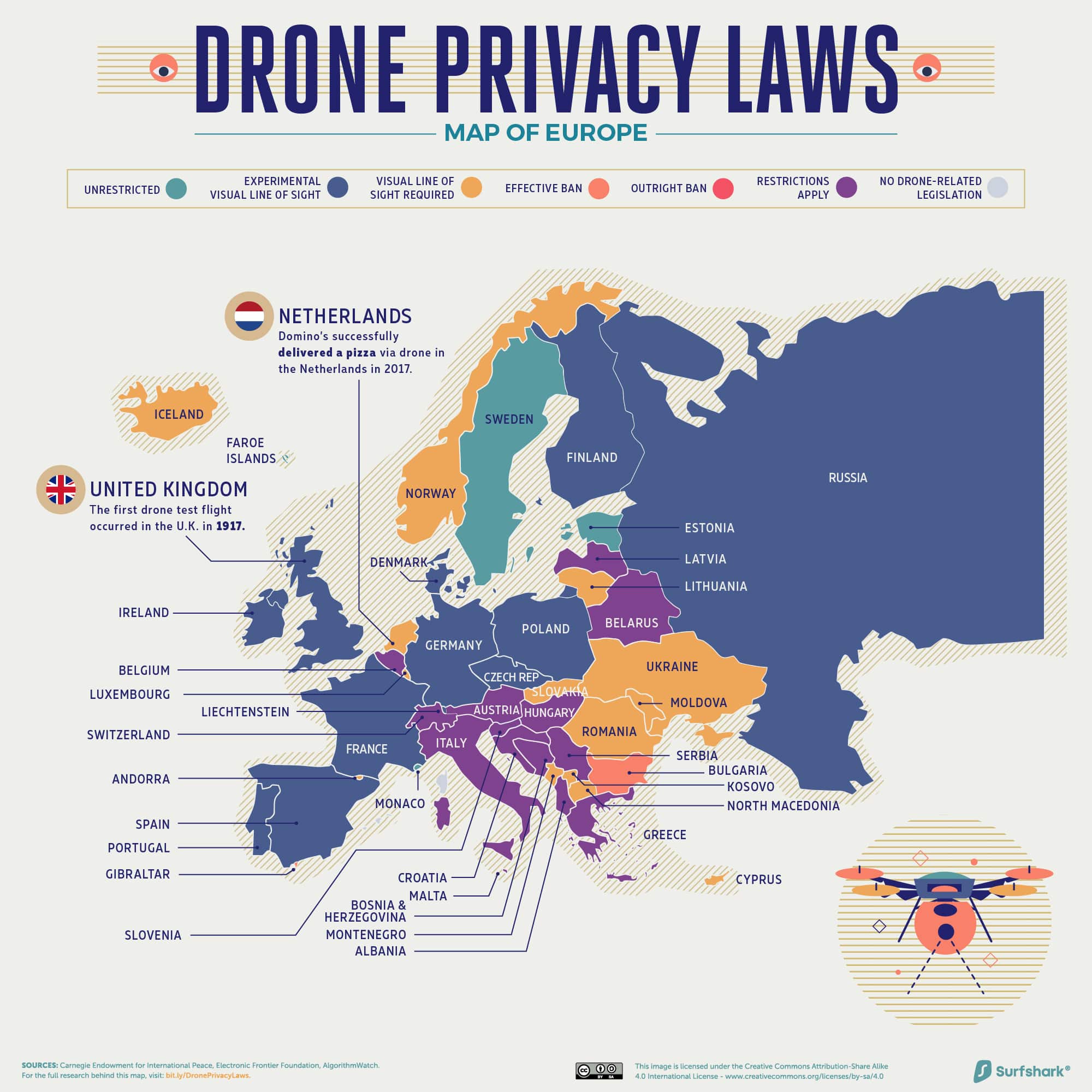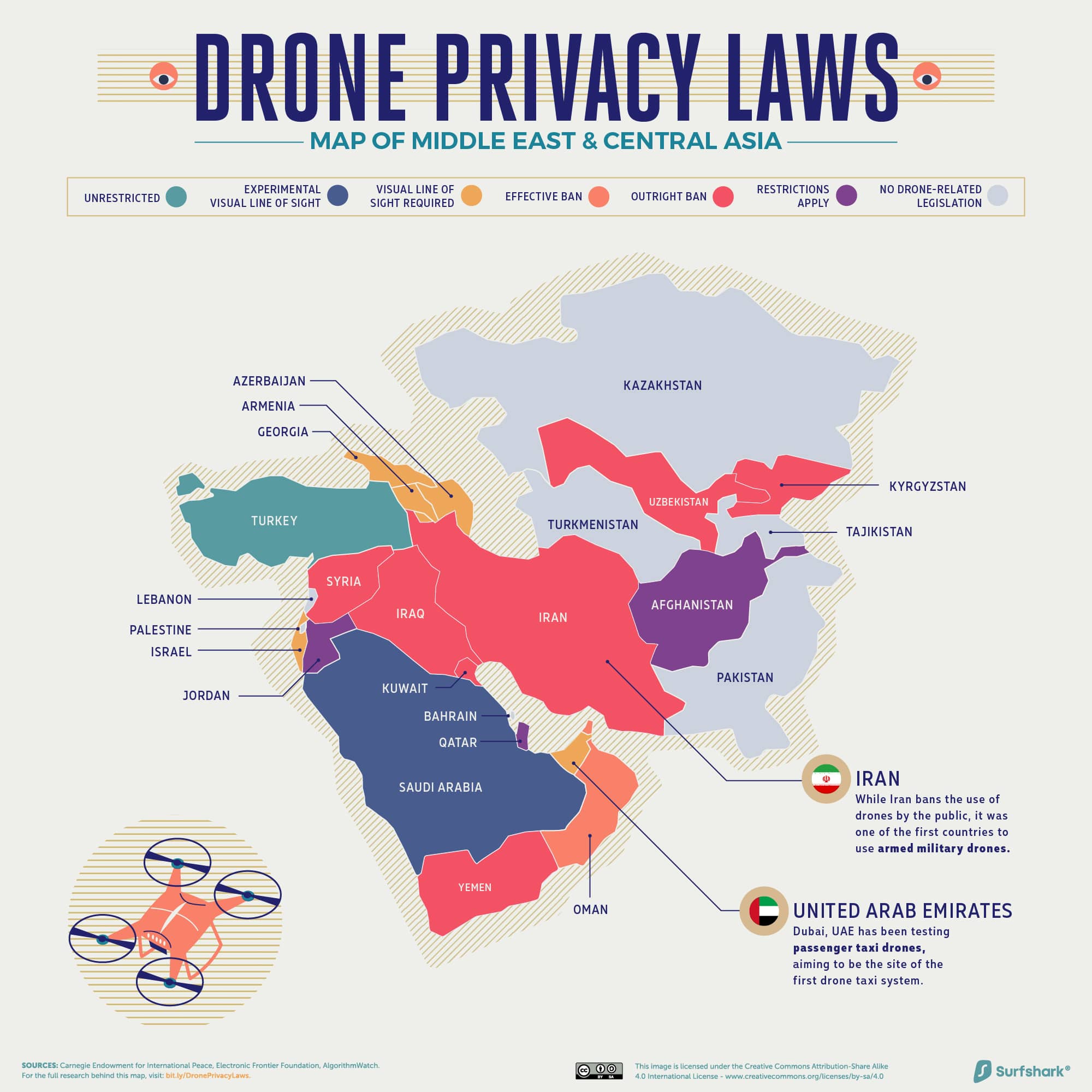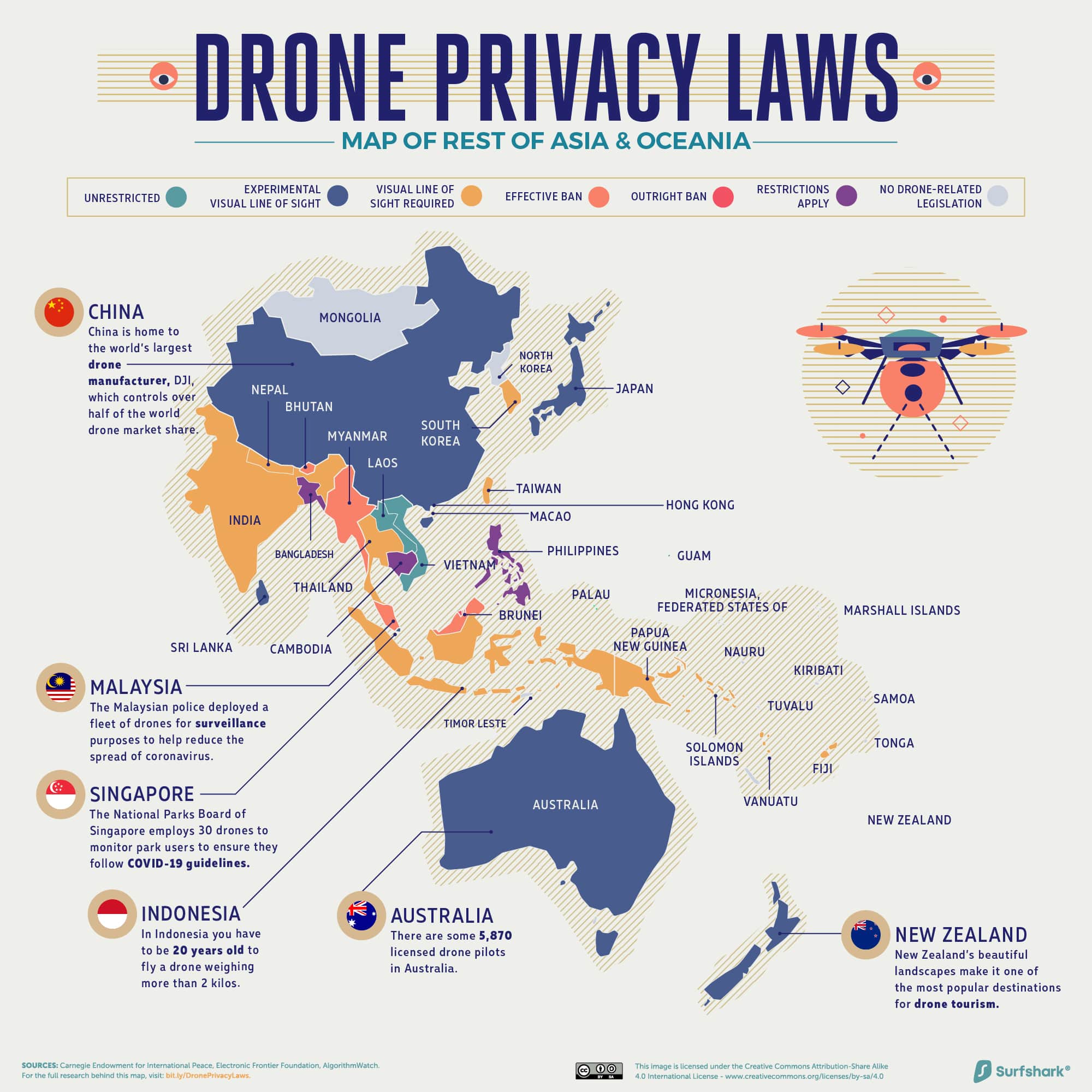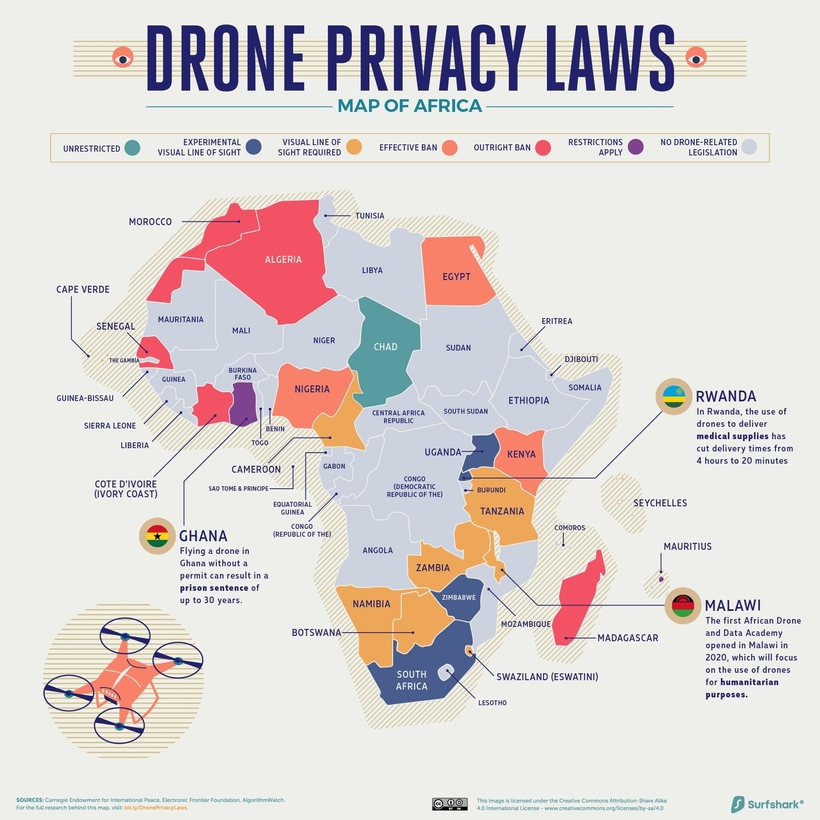From Olympic opening ceremonies to public safety, drone applications have come a long way. In fact, their modern applications are set to almost double the total value of the commercial drone market from $22.5 billion to $42.8 billion between 2020-2025, at a 13.8% compound annual growth rate (CAGR). Naturally, such diverse and complex uses can go quickly awry if not monitored and regulated correctly by governments—yet in some cases, it’s because of governments that drones’ uses border on sinister. This in-depth map from Surfshark explores the murky guidelines surrounding drone privacy laws around the world, and some case studies of how they’re used in every region.
How Are Drone Privacy Laws Classified?
According to the map researchers, drone and unmanned aerial vehicle (UAV) regulations typically fall into one of the following buckets: Categories are assigned based on legislation as of October 2020. Clearly, there is some overlap among these categories. They are highly dependent on judgment calls made by specific legal authorities, and change based on what a drone is being used for. Explore the drone privacy laws in your specific country here:
So How Are Drones Used Worldwide?
The myriad of drone uses are literally and metaphorically up in the air—while they originated in military needs, drone uses now range from hobbies such as aerial photography to supporting disaster relief. The following regional maps show privacy laws in closer detail, while also highlighting interesting case studies on how drones are used.
North America
Click here for the high-resolution version of this graphic. According to the latest drone numbers, 70.5% of registered U.S. drones are recreational, but these proportions may soon decline in favor of commercial uses. As of December 2020, civilian drones are allowed to fly over populated areas, a step towards fulfilling their potential in package delivery. Meanwhile, countries like Mexico are beginning to rely on drones to combat crime, with good results. In the city of Ensenada, a single drone’s surveillance patrol resulted in a 10% drop in overall crime rates in 2018. Drones are increasingly being used to monitor illicit activity such as drug trafficking routes.
South America
Click here for the high-resolution version of this graphic. Across the continent, drones are also in place to deliver everything from hospital supplies to life jackets in Chile and El Salvador.
Europe
Click here for the high-resolution version of this graphic. The first unmanned, radio-controlled aircraft test flight occurred in the United Kingdom in 1917. The Kettering Aerial Target (or “The Bug”) carried 180 pounds of explosives and became the basis for modern missiles. While Europe has some of the most liberal drone privacy laws today, that doesn’t mean they’re lenient. Even among countries that allow experimental visual lines of sight (such as Finland and Portugal), special permissions are required.
Middle East and Central Asia
Click here for the high-resolution version of this graphic. The military applications of drones persist in this region. Iran was one of the first to use armed drones and continues to do so, while simultaneously banning their public use. Neighboring Turkey also relies on kamikaze drones, augmented by AI and facial recognition, to strengthen border security.
Rest of Asia and Oceania
Click here for the high-resolution version of this graphic. China-based DJI is the world’s largest drone manufacturer, dominating 70% of the global market. Across Asia, drones have been in use for mass surveillance, particularly in China. In recent times, drones also track compliance with strict COVID-19 guidelines in Malaysia and Singapore. Meanwhile, in Japan, Nokia is testing out a drone network to provide a more rapid response to future natural disasters. The relief capabilities include disseminating more real-time updates and monitoring evacuation progress.
Africa
Click here for the high-resolution version of this graphic. While many parts of Africa haven’t developed any drone-related laws yet, promising innovation is rearing its head. Medical drones are already saving lives in Rwanda, delivering supplies in as little as 15 minutes. In the same vein, the pioneer African Drone and Data Academy (ADDA) opened in Malawi. The academy promotes drone usage for humanitarian and disaster preparedness, and aims to equip individuals with the relevant skills.
Towards Greater Heights?
As the uses of drones evolve over time, so will their legal status and the privacy concerns surrounding them. However, the adoption of any technology is always accompanied by a certain level of skepticism. With drones, it remains to be seen whether they’ll mostly occupy the role of a friend or a foe for years to come—and that power lies only in the hands of those who remotely control them. on Even while political regimes across these countries have changed over time, they’ve largely followed a few different types of governance. Today, every country can ultimately be classified into just nine broad forms of government systems. This map by Truman Du uses information from Wikipedia to map the government systems that rule the world today.
Countries By Type of Government
It’s important to note that this map charts government systems according to each country’s legal framework. Many countries have constitutions stating their de jure or legally recognized system of government, but their de facto or realized form of governance may be quite different. Here is a list of the stated government system of UN member states and observers as of January 2023: Let’s take a closer look at some of these systems.
Monarchies
Brought back into the spotlight after the death of Queen Elizabeth II of England in September 2022, this form of government has a single ruler. They carry titles from king and queen to sultan or emperor, and their government systems can be further divided into three modern types: constitutional, semi-constitutional, and absolute. A constitutional monarchy sees the monarch act as head of state within the parameters of a constitution, giving them little to no real power. For example, King Charles III is the head of 15 Commonwealth nations including Canada and Australia. However, each has their own head of government. On the other hand, a semi-constitutional monarchy lets the monarch or ruling royal family retain substantial political powers, as is the case in Jordan and Morocco. However, their monarchs still rule the country according to a democratic constitution and in concert with other institutions. Finally, an absolute monarchy is most like the monarchies of old, where the ruler has full power over governance, with modern examples including Saudi Arabia and Vatican City.
Republics
Unlike monarchies, the people hold the power in a republic government system, directly electing representatives to form government. Again, there are multiple types of modern republic governments: presidential, semi-presidential, and parliamentary. The presidential republic could be considered a direct progression from monarchies. This system has a strong and independent chief executive with extensive powers when it comes to domestic affairs and foreign policy. An example of this is the United States, where the President is both the head of state and the head of government. In a semi-presidential republic, the president is the head of state and has some executive powers that are independent of the legislature. However, the prime minister (or chancellor or equivalent title) is the head of government, responsible to the legislature along with the cabinet. Russia is a classic example of this type of government. The last type of republic system is parliamentary. In this system, the president is a figurehead, while the head of government holds real power and is validated by and accountable to the parliament. This type of system can be seen in Germany, Italy, and India and is akin to constitutional monarchies. It’s also important to point out that some parliamentary republic systems operate slightly differently. For example in South Africa, the president is both the head of state and government, but is elected directly by the legislature. This leaves them (and their ministries) potentially subject to parliamentary confidence.
One-Party State
Many of the systems above involve multiple political parties vying to rule and govern their respective countries. In a one-party state, also called a single-party state or single-party system, only one political party has the right to form government. All other political parties are either outlawed or only allowed limited participation in elections. In this system, a country’s head of state and head of government can be executive or ceremonial but political power is constitutionally linked to a single political movement. China is the most well-known example of this government system, with the General Secretary of the Communist Party of China ruling as the de facto leader since 1989.
Provisional
The final form of government is a provisional government formed as an interim or transitional government. In this system, an emergency governmental body is created to manage political transitions after the collapse of a government, or when a new state is formed. Often these evolve into fully constitutionalized systems, but sometimes they hold power for longer than expected. Some examples of countries that are considered provisional include Libya, Burkina Faso, and Chad.
